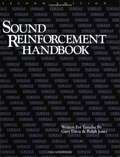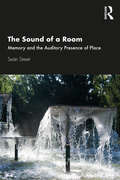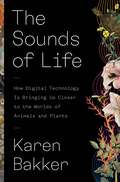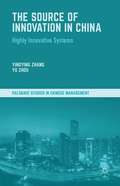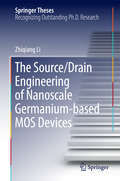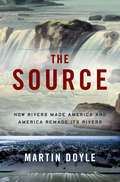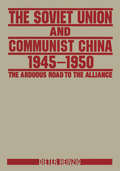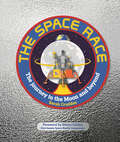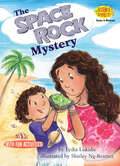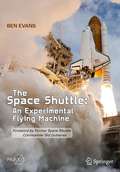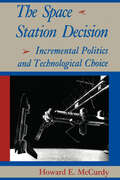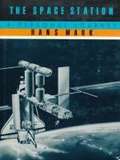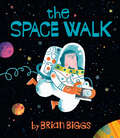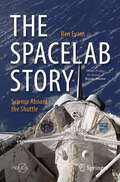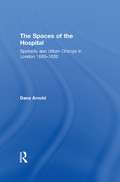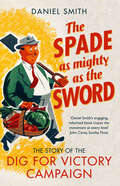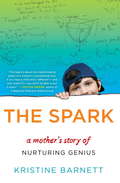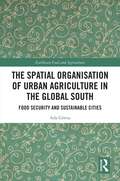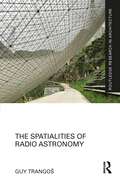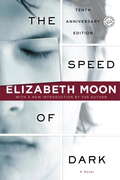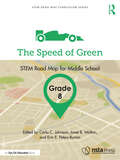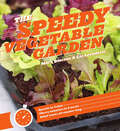- Table View
- List View
The Soul of a New Machine
by Tracy KidderComputers have changed since 1981, when Tracy Kidder memorably recorded the drama, comedy, and excitement of one company's efforts to bring a new microcomputer to market. What has not changed is the feverish pace of the high-tech industry, the go-for-broke approach to business that has caused so many computer companies to win big (or go belly up), and the cult of pursuing mind-bending technological innovations. The Soul of a New Machine is an essential chapter in the history of the machine that revolutionized the world in the twentieth century.<P><P> Winner of the National Book Award
The Sound Reinforcement Handbook
by Ralph Jones Gary DavisSound reinforcement is the use of audio amplification systems. This book is the first and only book of its kind to cover all aspects of designing and using such systems for public address and musical performance. The book features information on both the audio theory involved and the practical applications of that theory, explaining everything from microphones to loudspeakers. This revised edition features almost 40 new pages and is even easier to follow with the addition of an index and a simplified page and chapter numbering system. New topics covered include: MIDI, Synchronization, and an Appendix on Logarithms.
The Sound of Silence: Lowest-Noise RIAA Phono-Amps: Designer's Guide
by Burkhard VogelThere is a wide field of tasks left that can only be satisfyingly attacked with the help of old-fashioned analogue technology, and one of the most important are amplifiers for analogue signals. The strongly expanded content of the second edition of "the sound of silence" leads to affordable amplifier design approaches which will end up in lowest-noise solutions not far away from the edge of physical boundaries set by room temperature and given cartridges - thus, fully compatible with very expensive so called "high-end" or "state-of-the-art" offers on today markets - and, from a noise point of view in most cases outperforming them! With easy to follow mathematical treatment it is demonstrated as well that theory is not far away from reality. Measured SNs will be found within 1dB off the calculated ones and deviations from the exact amplifier transfer won't cross the ± 0.1dB tolerance lines. Additionally, the book presents measurement set-ups and results. Consequently, comparisons with measurement results of test magazine will soon become easier to perform. This new edition includes a new chapters about reference levels, Noise in Amp Input sections, Humming Problems, and much more.
The Sound of a Room: Memory and the Auditory Presence of Place
by Seán StreetWhat does a place sound like – and how does the sound of place affect our perceptions, experiences, and memories? The Sound of a Room takes a poetic and philosophical approach to exploring these questions, providing a thoughtful investigation of the sonic aesthetics of our lived environments. Moving through a series of location-based case studies, the author uses his own field recordings as the jumping-off point to consider the underlying questions of how sonic environments interact with our ideas of self, sense of creativity, and memories. Advocating an awareness born of deep listening, this book offers practical and poetic insights for researchers, practitioners, and students of sound.
The Sounds of Life: How Digital Technology Is Bringing Us Closer to the Worlds of Animals and Plants
by Karen BakkerAn amazing journey into the hidden realm of nature&’s soundsThe natural world teems with remarkable conversations, many beyond human hearing range. Scientists are using groundbreaking digital technologies to uncover these astonishing sounds, revealing vibrant communication among our fellow creatures across the Tree of Life.At once meditative and scientific, The Sounds of Life shares fascinating and surprising stories of nonhuman sound, interweaving insights from technological innovation and traditional knowledge. We meet scientists using sound to protect and regenerate endangered species from the Great Barrier Reef to the Arctic and the Amazon. We discover the shocking impacts of noise pollution on both animals and plants. We learn how artificial intelligence can decode nonhuman sounds, and meet the researchers building dictionaries in East African Elephant and Sperm Whalish. At the frontiers of innovation, we explore digitally mediated dialogues with bats and honeybees. Technology often distracts us from nature, but what if it could reconnect us instead?The Sounds of Life offers hope for environmental conservation and affirms humanity&’s relationship with nature in the digital age. After learning about the unsuspected wonders of nature&’s sounds, we will never see walks outdoors in the same way again.
The Source of Innovation in China
by Yu Zhou Yingying ZhangThis book discusses the rise of innovation in China and its source for this rapid increasing innovative capability. Focusing on the enterprises' innovation performance, not only technological innovation, but also process and strategy innovation is further debated surrounding the issue. The authors propose a high innovation system for an effective innovation performance in China. After an overview of the competitive advantages of Chinese enterprises based on low cost or on innovation, the book distinguishes different characteristics of Chinese innovation from the angle of organizational innovation type, ambidextrous effects and dynamic perspective of Chinese traditional culture, network-based innovation system, and the organizational innovative human system before discussing the challenges that Chinese enterprises face when they multinationalize overseas. Contrasting popular understanding of Chinese competitive advantages based on low labour, the authors highlight rising power of Chinese high performers in terms of innovation capability. Chinese enterprises' cases are employed for example illustration.
The Source/Drain Engineering of Nanoscale Germanium-based MOS Devices
by Zhiqiang LiThis book mainly focuses on reducing the high parasitic resistance in the source/drain of germanium nMOSFET. With adopting of the Implantation After Germanide (IAG) technique, P and Sb co-implantation technique and Multiple Implantation and Multiple Annealing (MIMA) technique, the electron Schottky barrier height of NiGe/Ge contact is modulated to 0. 1eV, the thermal stability of NiGe is improved to 600â,,f and the contact resistivity of metal/n-Ge contact is drastically reduced to 3. 8×10−7Ω*cm2, respectively. Besides, a reduced source/drain parasitic resistance is demonstrated in the fabricated Ge nMOSFET. Readers will find useful information about the source/drain engineering technique for high-performance CMOS devices at future technology node.
The Source: How Rivers Made America And America Remade Its Rivers
by Martin DoyleHow rivers have shaped American politics, economics, and society from the beginnings of the Republic to today. America has more than 250,000 rivers, coursing over more than 3 million miles, connecting the disparate regions of the United States. On a map they can look like the veins, arteries, and capillaries of a continent-wide circulatory system, and in a way they are. Over the course of this nation’s history rivers have served as integral trade routes, borders, passageways, sewers, and sinks. Over the years, based on our shifting needs and values, we have harnessed their power with waterwheels and dams, straightened them for ships, drained them with irrigation canals, set them on fire, and even attempted to restore them. In this fresh and powerful work of environmental history, Martin Doyle tells the epic story of America and its rivers, from the U.S. Constitution’s roots in interstate river navigation, the origins of the Army Corps of Engineers, the discovery of gold in 1848, and the construction of the Hoover Dam and the TVA during the New Deal, to the failure of the levees in Hurricane Katrina and the water wars in the west. Along the way, he explores how rivers have often been the source of arguments at the heart of the American experiment—over federalism, sovereignty and property rights, taxation, regulation, conservation, and development. Through his encounters with experts all over the country—a Mississippi River tugboat captain, an Erie Canal lock operator, a dendrochronologist who can predict the future based on the story trees tell about the past, a western rancher fighting for water rights—Doyle reveals the central role rivers have played in American history—and how vital they are to its future.
The Soviet Union and Communist China 1945-1950: The Arduous Road to the Alliance
by Dieter HeinzigDrawing on a wealth of new sources, this work documents the evolving relationship between Moscow and Peking in the twentieth century. Using newly available Russian and Chinese archival documents, memoirs written in the 1980s and 1990s, and interviews with high-ranking Soviet and Chinese eyewitnesses, the book provides the basis for a new interpretation of this relationship and a glimpse of previously unknown events that shaped the Sino-Soviet alliance. An appendix contains translated Chinese and Soviet documents - many of which are being published for the first time. The book focuses mainly on Communist China's relationship with Moscow after the conclusion of the treaty between the Soviet Union and Kuomingtang China in 1945, up until the signing of the treaty between Moscow and the Chinese Communist Party in 1950. It also looks at China's relationship with Moscow from 1920 to 1945, as well as developments from 1950 to the present. The author reevaluates existing sources and literature on the topic, and demonstrates that the alliance was reached despite disagreements and distrust on both sides and was not an inevitable conclusion. He also shows that the relationship between the two Communist parties was based on national interest politics, and not on similar ideological convictions.
The Space Barons: Elon Musk, Jeff Bezos, and the Quest to Colonize the Cosmos
by Christian DavenportThe historic quest to rekindle the human exploration and colonization of space led by two rivals and their vast fortunes, egos, and visions of space as the next entrepreneurial frontier. <P><P>The Space Barons is the story of a group of billionaire entrepreneurs who are pouring their fortunes into the epic resurrection of the American space program. <P>Nearly a half-century after Neil Armstrong walked on the moon, these Space Barons-most notably Elon Musk and Jeff Bezos, along with Richard Branson and Paul Allen-are using Silicon Valley-style innovation to dramatically lower the cost of space travel, and send humans even further than NASA has gone. <P>These entrepreneurs have founded some of the biggest brands in the world-Amazon, Microsoft, Virgin, Tesla, PayPal-and upended industry after industry. <P>Now they are pursuing the biggest disruption of all: space. <P>Based on years of reporting and exclusive interviews with all four billionaires, this authoritative account is a dramatic tale of risk and high adventure, the birth of a new Space Age, fueled by some of the world's richest men as they struggle to end governments' monopoly on the cosmos. <P>The Space Barons is also a story of rivalry-hard-charging startups warring with established contractors, and the personal clashes of the leaders of this new space movement, particularly Musk and Bezos, as they aim for the moon and Mars and beyond.
The Space Race: The Journey to the Moon and Beyond
by Sarah CruddasBlast off alongside space expert Sarah Cruddas on a ride-along through space exploration history with interviews from real astronauts!This children&’s space handbook takes you on a journey through the history of space exploration. Unpack space history, its future, and fascinating information on human exploration of our galaxy. This picture ebook will answer your kid's planet-sized questions.Suited for space-intrigued 7-9-year old&’s who are eager to learn about the galaxy! This children's ebook includes a foreword by NASA astronaut Eileen Collins, the first woman to command a space shuttle mission. Learn about real-life astronauts, including Apollo 17&’s Eugene Cernan and Virgin Galactic Test Pilot Kelly Latimer, who both give us insights about life in space! From man's dream on Earth about going into space to man&’s first steps on the moon and beyond, satisfy your interest of space by immersing yourself in first-hand thought-provoking stories and jaw-dropping visuals of this high quality, content-rich educational ebook. Read about the hidden stories behind the most famous space missions, before embarking on a journey through our space future. Propelled by recent scientific discoveries and printed to coincide with the 50th anniversary of the Apollo 11 Moon landing, The Space Race is an essential children's handbook to understanding every aspect of the history, and future, of human space travel.Track Our Incredible Human Journey Through The Cosmos Track our incredible human journey through the cosmos. Delve into 50 years of space exploration with Sarah Cruddas, who shares exciting first-hand experiences of real astronauts and milestone events. How did we land on the Moon? What will the space jobs of the future look like? And why did we send a car to space? The Space Race answers all of the big questions that kids have about space travel.Let your children explore their own questions with factual content that will leave them captivated and perhaps, who knows, want to become an astronaut too someday?This educational space ebook takes you on a journey through:- History of the race to the moon- Trailblazers in space exploration- The new space race - The future of space innovation
The Space Rock Mystery: Rocks And Minerals (Science Solves It!)
by Lydia LukidisSolve kid-sized dilemmas and mysteries with SCIENCE SOLVES IT! These fun science books for kids ages 5–8 blend clever stories with real-life science. Why did the dog turn green? Can you control a hiccup? Is that a UFO? Find the answers to these questions and more as kid characters dive into physical, life, and earth sciences. "This rock is totally from outer space!" At least that&’s what Kaleo thinks when he picks up an amazing rock on the beach. Finding out more will lead him and his sister, Leia, on an adventure they&’ll never forget! Books in this perfect STEM series will help kids think like scientists and get ahead in the classroom. Activities and experiments are included in every book!
The Space Shuttle (Springer Praxis Books)
by Ben EvansThis book explains how the achievements of the Space Shuttle, the world’s first reusable manned spacecraft, were built on the foundation of countless technical challenges. <p><p> Through thick and thin, the Space Shuttle remained the centerpiece of the American human spaceflight program for three decades. In addition to deploying satellites, planetary probes and, of course, the Hubble Space Telescope, it delivered astronauts to the Mir space station and assembled and sustained the International Space Station. Yet the path to these incredible achievements was never an easy one, with some obstacles resulting in the loss of life and other major consequences that plagued the fleet throughout its operational career. <p><p> The book adopts a challenge-by-challenge approach, focusing on specific difficulties and how (if at all) they were fully overcome. Going beyond the technical issues, it relates the human stories of each incident and how changes were effected in order to make the shuttle an exceptionally safer—though still experimental—flying machine.
The Space Station Decision: Incremental Politics and Technological Choice (New Series in NASA History)
by Howard E. McCurdySelected by Choice Magazine as an Outstanding Academic TitleOutstanding Academic Title, 1991, Choice MagazineAlthough building a space station has been an extraordinary challenge for America's scientists and engineers, the securing and sustaining of presidential approval, congressional support, and long-term funding for the project was an enormous task for bureaucrats. The Space Station Decision examines the history of this controversial initiative and illustrates how bureaucracy shapes public policy. Using primary documents and interviews, Howard E. McCurdy describes the events that led up to the 1984 decision to build a permanently occupied, international space station in low Earth orbit.As he follows the trail of the space station proposal through the labyrinth of White House policy review, McCurdy explains the evolution of the presidential budget review process, the breakup of the cabinet system, the proliferation of subcabinets and Executive Office interagency, the involvement of White House staff in framing issues for presidential review, and the role of bureaucracy in advancing administration legislation on Capitol Hill. Comparing the space station decision to earlier decisions to go to the moon and to build the space shuttle, McCurdy shows how public officials responsible for long-term science and technology policy maneuvered in a political system that demanded short-term flexibility.
The Space Station: A Personal Journey
by Hans MarkThis insider's account, a penetrating view of science policy and politics during two presidencies, captures the euphoria that characterized the space program in the late seventies and early eighties and furnishes an invaluable perspective on the Challenger tragedy and the future of the United States in space.President Reagan's approval of $8 billion for the construction of a permanently manned orbiting space station climaxed one of the most important political and technological debates in the history of the U.S. program in space. In The Space Station the story of this debate is told by Hans mark, who had major roles in the development of the space shuttle from its beginnings in the sixties and who bore a primary responsibility for overseeing the space station project during the decisive years from 1981 to 1984.Mark's appointment to the post of deputy administrator of NASA capped a career devoted to the development and management of space technology--he served as director of NASA's Ames Research Center, then as under secretary and later secretary of the U.S. Air Force. Serving under both President Carter and President Reagan, mark is uniquely able to chronicle the intricate process by which the space shuttle became a reality and the space station an acknowledged goal of the American space effort.A scientist by training, Mark's account of his career in the space program is the story of a personal dream as well as the story of a vast public enterprise whose human side is only now being fully appreciated.
The Space Walk
by Brian BiggsOne small step for man is one giant leap for friendship in this funny kid-level space adventureAstronaut Randolph Witherspoon wants to take a walk--a space walk, that is! But Ground Control has other ideas. Randolph must eat some lunch, get some exercise, and then he can go outside, provided he dresses warmly and doesn't talk to strangers. But Randolph's mission doesn't exactly go to plan, leading to an unexpected new friend. Brian Biggs puts an interstellar spin on the parent-child relationship in this hilarious new picture book.
The Spacelab Story: Science Aboard the Shuttle (Springer Praxis Books)
by Ben EvansBetween 1983 and 1998, Spacelab provided NASA with a vital short-term laboratory in space. Across more than a dozen missions, Spacelab’s pressurized research modules and science pallets supported hundreds of experiments from the life to microgravity sciences, from Earth science to astrophysics and from materials processing to fluid dynamics. For the first time, The Spacelab Story sheds light on all the Spacelab missions that served as pathfinders for the eventual International Space Station, along with all the flights that never came to be. The book chronicles over two decades of service and international partnership with Germany, Japan, Canada, Russia, the member-states of the European Space Agency and others. The very same international co-operation that led to Spacelab’s genesis also conspired to create its end. Science writer Ben Evans chronicles this tumultuous history, showing how, as tensions between the superpowers cooled in the 1990s and the Shuttle cameto be increasingly used to fly joint missions to Mir, many Spacelab missions were delayed and eventually cancelled. This book is a must-read for anybody interested in the science conducted aboard the Shuttle, the experimental precursors of the ISS, and the international politics surrounding NASA’s pioneering space endeavors.
The Spaces of the Hospital: Spatiality and Urban Change in London 1680-1820
by Dana ArnoldThe Spaces of the Hospital examines how hospitals operated as a complex category of social, urban and architectural space in London from 1680 to 1820. This period witnessed the transformation of the city into a modern metropolis. The hospital was very much part of this process and its spaces, both interior and exterior, help us to understand these changes in terms of spatiality and spatial practices. Exploring the hospital through a series of thematic case studies, Dana Arnold presents a theoretically refined reading of how these institutions both functioned as internal discrete locations and interacted with the metropolis. Examples range from the grand royal military hospital, those concerned with the destitute and the insane and the new cultural phenomenon of the voluntary hospital. This engaging book makes an important contribution to our understanding of urban space and of London, uniquely examining how different theoretical paradigms reveal parallel readings of these remarkable hospital buildings.
The Spade as Mighty as the Sword: The Story of the Dig for Victory Campaign
by Daniel SmithThe little-known history of the “Garden Front”—Britain’s wildly successful vegetable-growing campaign during WWII: “A fascinating story.” —Northern EchoAfter food rationing was introduced in 1940, and German U-boats began threatening merchant shipping bringing in essential foodstuffs, the Ministry of Agriculture decided something had to be done to make the kitchens of Britain more self-sufficient.The result was an amazingly effective campaign—Dig for Victory—encouraging every man and woman to turn their garden, or even the grass verge in their street, over to cultivating vegetables. By 1942 half the population were taking part, and even the Royal Family had sacrificed their rose beds for growing onions.Now, Daniel Smith tells the full story of this remarkable wartime episode when spades, forks, and bean canes became weapons the ordinary citizen could take up against the enemy. It had tangible benefits for the war effort in that shipping could be reallocated for munitions instead of food imports, as well as for the health of the nation in encouraging a diet of fresh fruit and veg. The campaign also created unexpected celebrities like C.H. Middleton, whose wartime BBC radio talks on gardening reached a vast audience, and even sowed the seeds for the modern allotment movement.Ultimately it is a war story without fighting or killing, one that shows how even The Little Man with the Spade, in the words of the Minister for Agriculture at the time, did his bit for Victory.“Engaging.” —The Sunday Times“An inspirational account.” —Lancashire Evening Post
The Spark: A Mother's Story of Nurturing, Genius, and Autism
by Kristine BarnettThe extraordinary memoir of a mother's love, commitment and nurturing, which allowed her son, originally diagnosed with severe autism, to flourish into a universally recognized genius--and how any parent can help their child find their spark. Today, at 13, Jacob is a paid researcher in quantum physics, working on extending Einstein's theory of relativity. Diagnosed at 1 with severe autism, at 3 he was assigned to life-skills classes and his parents were told to adjust their expectations. The goal: tying his own shoes at 16. Kristine's belief in the power of hope and the dazzling possibilities that can occur when we keep our minds open and learn to fuel a child's true potential changed everything.From the Hardcover edition.
The Spatial Organisation of Urban Agriculture in the Global South: Food Security and Sustainable Cities (Earthscan Food and Agriculture)
by Ada GórnaThis book examines the role and position of urban agriculture in the spatial and functional structure of cities in the Global South.In the face of dynamic urbanisation and negative consequences of climate change, one of the key challenges is not only how to provide food for the ever-growing urban population but also how to achieve urban sustainability and simultaneously reduce the negative impact of cities on the natural environment. These problems are particularly urgent in the metropolises of the Global South that are experiencing the greatest population growth while struggling with increasing social inequalities and the resulting uneven distribution of resources. Examining the role that urban agriculture can play in addressing these challenges, this book draws on three case study cities: Havana, Singapore and Kigali. The case studies, differing in socio-economic, spatial, political and environmental terms, exemplify diverse characteristics of urban agriculture in different geographical conditions. Drawing on fieldwork conducted in each city, the book also provides a unique perspective on the constraints in the development of urban agriculture and the use of its full potential for urban sustainability.This book will appeal to students and scholars, as well as decision makers, interested in the issues of urban sustainability, food security, spatial development and alternative food systems.
The Spatialities of Radio Astronomy (Routledge Research in Architecture)
by Guy TrangošThe Spatialities of Radio Astronomy examines the multidisciplinary overlap between the spatial disciplines and the studies of science and technology through a comparative study of four of the world’s most important radio telescopes. Employing detailed analysis, historical research, interviews, personal observations, and various conceptual manoeuvres, Guy Trangoš reveals the depth of spatial process active at these scientific sites and the territories they traverse. Through the conceptual frameworks of territory, hyper-concentration, and contingency, Trangoš interprets the telescope as exploded across space and time, present in multiple connected sites simultaneously, and active in the production of space. He develops a historiographic and contemporary analysis of the Atacama Large Millimeter/submillimeter Array (ALMA, Chile); the Five-hundred-meter Aperture Spherical radio Telescope (FAST, China); the Arecibo Observatory (Puerto Rico); and the MeerKAT/SKA (South Africa). These case studies are global exemplars of the different spatial transformations that occur through science. Their relationships to surrounding communities and landscapes reveal deeper constitutional processes embodied in each institutional and spatial form. This book spans the modern history of architecture and science, the studies of science, technology and society, and urban theory. It is of specific interest to architects and designers expanding their analysis of spatial production, scholars in the study of geography, landscape, science, technology, and astronomy, and people fascinated with how these radio telescopes were conceptualised, built, and operate today.
The Speed of Dark
by Elizabeth MoonTenth anniversary edition • With a new Introduction by the author<P><P> In the near future, disease will be a condition of the past. Most genetic defects will be removed at birth; the remaining during infancy. Lou Arrendale, a high-functioning autistic adult, is a member of the lost generation, born at the wrong time to reap the rewards of medical science. He lives a low-key, independent life. But then he is offered a chance to try a brand-new experimental “cure” for his condition. With this treatment Lou would think and act and be just like everyone else. But if he was suddenly free of autism, would he still be himself? Would he still love the same classical music—with its complications and resolutions? Would he still see the same colors and patterns in the world—shades and hues that others cannot see? Most important, would he still love Marjory, a woman who may never be able to reciprocate his feelings? Now Lou must decide if he should submit to a surgery that might completely change the way he views the world . . . and the very essence of who he is.<P> Thoughtful, provocative, poignant, unforgettable, The Speed of Dark is a gripping journey into the mind of an autistic person as he struggles with profound questions of humanity and matters of the heart.<P> Nebula Award Winner
The Speed of Green, Grade 8: STEM Road Map for Middle School (STEM Road Map Curriculum Series)
by Carla C. Johnson Erin E. Peters-Burton Janet B. WaltonWhat if you could challenge your eighth graders to design a racing vehicle with minimum environmental impact, while exploring the role of renewable and non-renewable energy sources? With this volume in the STEM Road Map Curriculum Series, you can! The Speed of Green outlines a journey that will steer your students toward authentic problem solving while grounding them in integrated STEM disciplines. Like the other volumes in the series, this book is designed to meet the growing need to infuse real-world learning into K–12 classrooms. This interdisciplinary, eight-lesson module uses project- and problem-based learning to help students explore the potential role of renewable and non-renewable energy sources in transportation, with an emphasis on the auto industry. Using their understanding of the engineering design process (EDP), scientific concepts, and environmental conservation considerations, student teams will develop a plan for a competitive automobile racing team to fuel its vehicle with minimal environmental impact. To support this goal, students will do the following: · Identify finite energy resources and distinguish between these and renewable energy sources, and identify implications of the use of those fuel sources on the environment; · Conduct life cycle analyses (LCAs) of various fuel sources and apply the results to make decisions about the effects of various fuel sources; · Identify several ways that carbon-based fuels have impacted the U.S. economy and foreign relations; · Identify the effects of human activities on the biosphere with an emphasis on the effects of the widespread use of carbon-based fuels; · Apply the engineering design process (EDP) to solve a problem, and design and build a small-scale electric vehicle; · Synthesize their learning and working collaboratively by creating and presenting a plan for a race team that minimizes its environmental impact; · Create an engaging presentation incorporating oral presentations and visual displays to present projects to an audience of peers, teachers, and industry professionals. The STEM Road Map Curriculum Series is anchored in the Next Generation Science Standards, the Common Core State Standards, and the Framework for 21st Century Learning. In-depth and flexible, The Speed of Green can be used as a whole unit or in part to meet the needs of districts, schools, and teachers who are charting a course toward an integrated STEM approach.
The Speedy Vegetable Garden
by Mark Diacono Lia LeendertzTypically, vegetable gardening is about the long view: peas sown in spring aren't harvested until summer, and tomatoes started indoors in February can't be eaten until July. But it's not true for all plants. Some things can be planted and eaten in weeks, days, even hours.The Speedy Vegetable Garden highlights more than 50 quick crops, with complete information on how to sow, grow, and harvest each plant, and sumptuous photography that provides inspiration and a visual guide for when to harvest. In addition to instructions for growing, it also provides recipes that highlight each crop’s unique flavor, like Chickpea sprout hummus, stuffed tempura zucchini flowers, and a paella featuring calendula. Sprouted seeds are the fastest. Microgreens can be harvested in weeks: cilantro, 14 days after planting; arugula and fennel in 10 days. And a handful of vegetable varieties grow more quickly than their slower relatives, like dwarf French beans (60 days), cherry tomatoes (65 days), and early potatoes (75 days).The Speedy Vegetable Garden puts fresh, seed-to-table food at your fingertips, fast!

